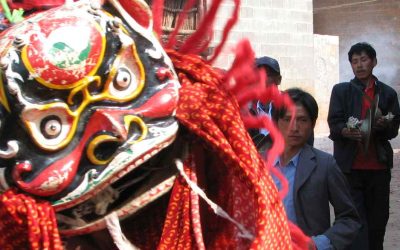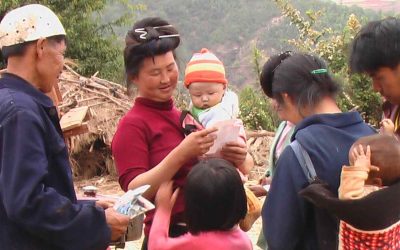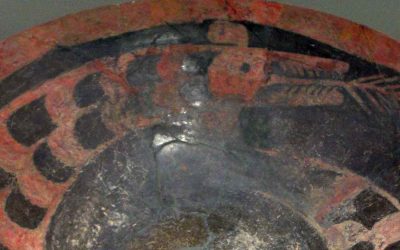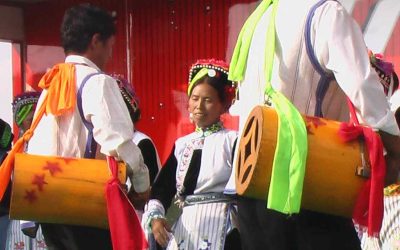The Bull that Shaped the World and Other Sacred Bovines among the Bulang Minority
The Bulang people (布朗族), an Austroasiatic ethnic group primarily inhabiting Yunnan’s tea-growing highlands, revere the ox as a sacred being intertwined with creation, agriculture, and spiritual power. The ox appears in their myths, agricultural rituals, festivals, and social customs, representing strength, prosperity, and spiritual connection. The Bulang’s ox traditions are uniquely tied to tea cultivation, cosmic order, and ancestral blessings.
In the Beginning, There Was the Ox
Among some Bulang, the ox is considered a sacred animal that helped in creation or provided sustenance to early humans. The creation myth Gumiye tells of a big ox that created everything that exists in this world. After the creation was completed, he used his four legs to keep the heaven stable. In some versions, the ox plowed the earth with its horns, creating mountains and valleys, its sweat formed rivers, and its breath brought wind, allowing life to flourish.
The Ox and the Beginning of Agriculture
There are also tales that link the ox to the origins of agriculture. One legend tells of a heavenly ox that descended to earth carrying the first grains of rice or millet in its mouth (or dung). In another one, a Bulang ancestor followed the ox and discovered that where it rested, crops sprouted. In some others, the ox then taught people how to plow and sow, linking it to the origin of farming, or a divine or heroic ox teaches the Bulang people farming techniques, emphasizing the animal’s role in their transition from hunting to agriculture.
These myths explain why the ox has a central role in some rituals related to the traditionally swidden (slash-and-burn) agriculture. Its presence is especially important in the Plowing Ceremonies, performed before planting, when rituals are performed to honor the ox; and in Thanksgiving Festivals, after harvest, when Bulang communities express gratitude to the ox for its work. They decorate cattle, feed them special foods, and perform dances. In some places, the Ox Dance (牛舞) imitates ox movements, symbolizing fertility and strength.
The Ox and the Origin of Tea
Other myths relate it to tea. They tell of a demon (or drought spirit) that devoured crops until a sacred ox challenged it. The ox fought the demon for days, finally trampling it into the earth. Where the demon’s blood fell, the first tea plants grew. The ox then collapsed, and its body became a mountain that protected the village. Other versions state that after the battle, the people discovered that where an ox’s blood fell, the first tea plants appeared. The transformation of blood into tea is unique to the Bulang. Some of their tea fields are protected by oxen heads, and in some villages in Mengsong (勐宋) district, they perform ox sacrifices during tea-harvesting ceremonies, recalling the myth.
Spiritual Role of the Ox
The ox also has a sacrificial and spiritual role. Due to its ability to communicate with heavenly deities, it is sacrificed to honor ancestors or deities, believing that it will carry the prayers to the spirit world. Oxen are also central to other festivals. In New Year and Harvest Festivals, the ox is sometimes paraded or decorated. In some villages, an ox made of dough or straw is offered to ancestors, mirroring the cosmic ox’s sacrifice. In Xishuangbanna, the «Gangyong» (岗永) Festival includes a ritual ox sacrifice to pray for rain/harvest, tied to the demon-slaying myth. In Lincang, they have an Ox King Festival, held on the 8th day of the 4th lunar month (similar to Han Chinese Ox King festivals), which focuses on thanking oxen for labor—feeding them sticky rice and let them rest the whole day.
Ox bones are perceived as full of magical power, and they are used sometimes in traditional divination. There are no studies to ascertain if this was an independent development or could be related to the Oracle Bone divination practiced in China more than 3,000 years ago.
Conclusion
The ox in Bulang culture is more than just a farm animal—it embodies labor, sustenance, and spiritual connection. Its presence in myths, rituals, and daily life underscores its role as a symbol of resilience, prosperity, and communal harmony. Its economic and religious value makes the ox second only to people in Bulang symbolic thought. Owning cattle was historically a sign of prosperity among them, and oxen were used in trade or as bride prices in marriages.
About me: I have spent 30 years in China, much of the time traveling and studying this country’s culture. My most popular research focuses on Chinese characters (Chinese Characters: An Easy Learning Method Based on Their Etymology and Evolution), Matriarchy in China (there is a book with this title), and minority cultures (The Naxi of Southwest China). In my travels, I have specialized in Yunnan, Tibet, the Silk Road, and other lesser-known places. Feel free to write to me if you’re planning a trip to China. The agency I collaborate with offers excellent service at an unbeatable price. You’ll find my email below.
Last posts
The bull and the political development of Neolithic China
The bull and the political development of Neolithic China Since the history of the penetration of domestic cattle in China goes parallel to that of the political concentration that gave rise to the first cities and later to the first states, that slow penetration of...
THE LION-DANCE AS RELIGIOUS DANCE
THE LION-DANCE AS RELIGIOUS DANCE The lion-dancers first appeared in China under the Tang dynasty (a.d. 618-906), and made their debut at the court of the kings of Tibet about the same time. The lion-dancer represents a form of the Indian mime or burlesque juggler,...
The Flowery Miao in Zhaotong
The Flowery Miao in Zhaotong As depicted by E. G. KEMP in The Face of China. New York. 1909. The prefectural town of Zhaotong was reached after passing through a dull plain, across which a piercing wind was blowing, which is characteristic of this district. It is an...
Taosi. The first capital of China
Taosi. The first capital of China Taosi is one of the most important archaeological discoveries in China in the past decades. Located in the southern part of Shanxi province, is possibly the first urban center emerged in China. The excavation of the ancient city of...
Chinese character 疚 jiù – chronic disease
Chinese character 疚 jiù – chronic disease 1. chronic disease. 2. remorse. HSK - STROKES - 8 RADICAL - 疒 Elements ---- Illnes radical 疒 + long time 久. Phonetic series 久. It causes pain 疒 for long time 久. 内疚 nèijiù – remorse (inner + remorse) 疚心 jiùxīn – ashamed...
The Flood Myth, Shamans and the Sani Religion
The Flood Myth, Shamans and the Sani Religion We continue with the second chapter of Paul Vial “Los Lolos”, in which fragments dedicated to the myth of the flood and the activities of its shamans are particularly striking. CHAPTER II - RELIGIOUS TRADITIONS These...










